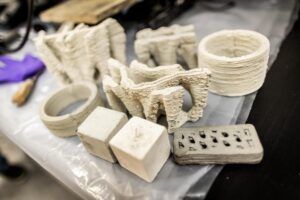New type of concrete captures more CO₂

(Credit: University of Pennsylvania)
July 8, 2025 – Concrete is responsible for nearly 9 percent of global greenhouse gas emissions. Researchers at the University of Pennsylvania have now developed a lighter, more sustainable alternative that absorbs far more carbon dioxide than conventional mixes.
The new material combines 3D printing with diatomaceous earth (DE), derived from fossilized microscopic algae. Thanks to DE’s porous structure, the concrete can capture up to 142 percent more CO₂. At the same time, it requires less cement while still meeting standard strength requirements.
The team developed a printable concrete ink and optimized variables such as water ratio and nozzle size. This allowed them to produce self-supporting, porous structures that used 68 percent less material while achieving a 500 percent increase in surface-to-volume ratio. A TPMS cube retained 90 percent of the strength of a solid block but absorbed 32 percent more CO₂ per unit of cement.
Future research is focusing on scaling up to structural elements such as floors and façades, as well as marine applications. Thanks to its porosity and ecological compatibility, this concrete may also be well suited for artificial reefs and coral platforms.









